Cuttings with mold.
When I took my three bags of cuttings out of the fridge on Sunday several had mold growing on them. I brushed them off and the redipped all the cuttings in a 10% bleach solution before wrapping in paper towels and placing in Ziplocs to start rooting. Unfortunately the mold has returned with a vengeance after a few days.
Are these cuttings no longer viable or can they be recleaned and tried again? I was thinking that the Ziplock method would promote mold, shall I try them i potting soil?
thanks, Rob
Comments (58)
tapla (mid-Michigan, USDA z5b-6a)
13 years agolast modified: 9 years agoRob - you can jump through a hundred hoops and you'll still be spinning your wheels. If you are using container media as part of your rooting strategy, and you DO have mold/fungal issues, it's VERY likely that the medium is the source of your fungaluglies.
There are thousands of species of molds and none or almost none require condensate to reproduce or to wreak havoc on cuttings. The various species of molds have a tremendous tolerance for the extremes of temperature and humidity levels. Many molds are active at temperatures below 40*, and can grow very well on surfaces that feel dry when we touch them. The two things required for mold to grow are mold spores and a suitable environment.
We are absolutely certain that cuttings contain moisture - probably about as much as that in the skin of an orange, yet mold grows very well on orange skins (and dry bread) if we keep them exposed to the same temperature at which we would keep our cuttings.
It's impossible to maintain perfectly stable temperatures in any type of propagation chamber the hobby grower might be using, and it makes absolutely no sense that near stable temperatures would inhibit reproduction of mold species. Perhaps Dan might cite something believable - something other than anecdote. You can't just pull a notion out of the air and treat it as fact when you present a case.
Imagine you have a closed system, such as a Ziploc bag with a cutting suspended in it and a moist medium in the bottom of the bag. The air in the closed bag will soon reach 100% relative humidity, making the dew point whatever the air temperature is. Dew will form on all surfaces inside the bag. As soon as there is a tiny upward temperature fluctuation in ambient temperatures, the bag will be warmer than the cutting and condensation will be most prevalent on the coolest surface, which will temporarily be the cutting - until the temperature of the cutting equalizes with the temperature of the bag. No matter how hard you wish it differently, it WILL happen as I described. As far as I know, relative humidity and dew points work the same today as they did yesterday.
If the bag or propagation chamber is vented, it still isn't important to keep temperatures stable to to keep dew from forming on the cuttings. E.g., if the bag or propagation chamber was vented so you were maintaining 90% relative humidity, you have a 3* range to play with. As long as the temperature of the cutting was never any more than 3* cooler than the air surrounding the cutting, no condensate would form on the cutting. If you maintained 80% relative humidity in the propagation chamber the dew point would be 6* cooler than air temp and at 70* it would be 9*. From this you can easily see that the idea that simply maintaining a stable temperature in hopes that it will eliminate moisture formation on cuttings is pure bunk.
Temperature can change over a wide range. Technically, ambient air temperatures can fall very quickly in a vented system and no condensation will form on the cutting, but when temperatures rise, they must rise slowly enough that there is only a 3* difference (or less) in temperature between the cutting and air temperature at 90% relative humidity, a 6* difference at 80% and a 9* difference at 70% relative humidity. This can be easily verified.
I totally agree that we should "Follow good fig cutting procurement & storage practices as well as rooting methods ...", but cannot understand how in one breath someone could preach cleanliness, sterility, and jumping through 100 hoops, and in the next suggest a rooting medium guaranteed to contain millions of fungal (mold) spores.
Al
danab_z9_la
13 years agolast modified: 9 years agoHere we go again.....
Al,
I'm sorry that you do not seem to understand some very simple scientific concepts. I do not have the patience nor the desire to teach them to you. For you to try to preach to me about dew points, humidity, and condensation is absolutely ridiculous. I am an EXPERT in that area of physical chemistry. Uncontrolled moisture (condensation in this case) is about absolute humidity, relative humidity, temperature, & atmospheric pressure and how these independant variables affect each other. What I have posted is for the benefit of others seeking solutions to their mold problems. Contrary to your beliefs, what I have posted works and works very well. Let me repeat that.....IT WORKS VERY WELL. Funny how you continue to argue against PROVEN RESULTS and any viable alternatives to your way of doing things. Funny how you seem to understand osmosis going in one direction and do not seem to understand that it CAN go both ways. I am tiring of your continuing attitude that only your way is the right way. What could possibly be wrong with a detailed rooting method that consistently yields a near 100% rooting success? Why do you continue to bash it while you still have not even posted your preferred "chainsaw" method?? For the umpteenth time, it is THE RESULTS that matter not your pet theories. What part of RELIABLE AND PROVEN RESULTS do you not understand??? In the arena of science, RESULTS trump "theory" every time. Too bad if you do not see the merits of the superior (yes I said SUPERIOR) perlite/UPM rooting mix and the proven benefits derived from rooting at near a constant room temperature. Too bad if you do not understand the mold triangle and how it is used to PREVENT mold.
It is time for you to stop with your declared "stamping out" campaign against my posts. For the umpteenth time, the information that I post on this fig forum is good, relevant, useful, and very reliable information that is intended for open minded forum members. Anyone (including you) can verify for themselves the validity of what I have posted in this thread. Fig Horticulture is NOT a science.... there are many ways to propagate fig cuttings and there are many ways to grow them. My viewpoint is a valid one. It's just too bad if what I post does not agree with some of your past posts....get over it.
Dan
Related Professionals
Eden Prairie Landscape Architects & Landscape Designers · Havre de Grace Landscape Architects & Landscape Designers · Edmond Landscape Contractors · Flagstaff Landscape Contractors · Glendale Heights Landscape Contractors · Oklahoma City Landscape Contractors · South Lake Tahoe Landscape Contractors · Wallingford Landscape Contractors · San Pablo Landscape Contractors · Dayton Decks, Patios & Outdoor Enclosures · Barrington Fence Contractors · Canby Fence Contractors · Columbia Fence Contractors · Tacoma Fence Contractors · Savage Fence Contractorstapla (mid-Michigan, USDA z5b-6a)
13 years agolast modified: 9 years agoAgain you sidestep and just tell everyone how good your information is and how expert you are, but don't address any of the issues I pointed out. You'd have people jumping through a bunch of unnecessary hoops only to advise them to undo their efforts by sticking cuttings in an unsterile mudium, then lay the blame at their feet when their efforts end in failure.
As I've pointed out, there are MANY rooting methods that work very well with figs because of their genetic vigor; and the only reason there aren't even more problems with rooting in bags is because figs ARE so vigorous - not because the rooting method is anything other than mediocre.
I'm not bashing you, or arguing FOR any particular method(s), much less anything I would be so presumptuous as to call mine. I'm offering a different perspective on all these directives and observations (that go totally against sound science) you pull out of the air with no support and seem to think are helpful, while using proven science and my own practical experience to point out exactly why they are not.
Al
danab_z9_la
13 years agolast modified: 9 years agoAl, you are sooooooooo misguided by some of your pet theories and beliefs. See, I believe that you are misguided as much as you think that I am misguided.....tit for tat. IMO, this keeps you from recognizing the merits of what others have to say about fig horticulture on this forum.
Regarding my answering your questions. As you have told me before......"I don't dance to your tune" either. However, please keep right on reading my posts and maybe you will learn a few "new" things about FIGS. NO ONE has cornered the market on fig horticulture & knowledge and that's why we all come here and read the posts. I enjoy posting and reading information about FIGS and really could care less about the propagation & growing of other plants.
I am prepared to have others determine the validity and the practicality of my suggestions. Can you say the same?? Wasn't it you that had problems with those "supposedly bad" phyto toxins....Bleach and Caustic Soap? Do you still believe that those chemicals are harmful to cuttings?? Maybe you have changed your position because now we know that many forum members KNOW FROM THIER OWN FIRST HAND EXPERIENCE that these bad toxic chemicals can be very helpful in improving their fig cutting rooting success. Also, aren't you a leading proponent of using a heating mat in an indoor rooting environment where IT IS ABSOLUTELY NOT NEEDED??? It is a fact that heating mats can do more damage than good. Is that an indoor rooting technique that you are still trying to defend??? The fact remains......uneven heating caused by heating pads and/or other heat sources is often the MAIN REASON why many hobby forum members lose their cuttings to mold and rot. That is why rooting at a near constant room temperature is much better. Try to understand and appreciate this fact even if it conflicts with your past posts and suggestions. There is no telling how much fig wood has been lost due to the improper use of unnecessary heating pads.....probably enough to build many houses.
You say, " Dan would have people jumping through a bunch of unnecessary hoops only to advise them to undo their efforts by sticking cuttings in an non sterile medium, then lay the blame at their feet when their efforts end in failure."
To that I say MEGA BALONEY!!!! Try actually reading my posts rather than merely reacting to them and looking for some "nit" to pick. What I ALWAYS SAY when trying to help others deal with mold is for them to lean HOW TO PREVENT it from occurring in the first place. Need proof.....re-read what information that I have posted above. Did you not see that I identified a "Barking" problem for the OP and suggested ways him to deal with it?? Where have you seen such practical information before???? Don't you think it important to teach new fig rooters the difference between Barking and mold??? And how to deal with those situations?? Too, I did not see you offering any advice to the original poster......why not?? No, you chose to go with another of your "stamping out" Dan's mis information BS sessions immediately following my helpful suggestions to the original poster. It is time for you to stop that behavior. Stop it.
FYI.....Once mold starts, rooters will have problems even if the cuttings are placed in a "sterile" medium. Contrary to your belief..... rooting in UPM DOES NOT INCREASE problems with mold. In fact, it is very easy to root fig cuttings with MONSTER ROOTS using UPM without ever seeing any mold whatsoever. Of course you wouldn't know that because you told us that you have never used the product....not even once. Funny how you claim to "know" the results to be expected of a product that you have never even used. Yet you continue to completely disregard the PROVEN RESULTS of those who have actually used the product. How scientific is that???? Your position and understanding of science seems awfully misguided to me.
Finally, why don't you get off of your high horse and stop preaching to my deaf ears. Once and for all..........put your DETAILED alternative method(s) in writing for the benefits of others who are having problems rooting their cuttings. Don't do this for me...as I certainly don't need your help or advice for growing my figs. Give fellow forum members (not me) that "chainsaw" method that you claim to have. Give others (not me) the benefit of your alternative method(s). Give others (not me) the benefit of your practical experience. Put it "IN WRITING" so there will be no confusion nor any questions about the details.
However, I am again asking that you do allow me to post my information in peace on this forum. Fig Horticulture ain't NO SCIENCE. I have a very strong and valid alternate viewpoint than yours. Again, I don't care if what I post is in disagreement with any of your past postings, experience, beliefs, or pet theories....get over it...we agree to disagree. Let others decide what is relevant to them.
How 'bout DEM figs!!! Well they do just fine right here in South Louisiana. I wish the same for everyone.
Dan
tapla (mid-Michigan, USDA z5b-6a)
13 years agolast modified: 9 years agoGee, Dan - every time I disagree with you and point to the myriad holes in your theories, all we get is another diatribe like immediately above. You spent months crying about a passing comment and using it as an excuse to continually attack me and anything I say, and now you're wanting to be left in peace to post erroneous information.
I wasn't talking about heating pads, I was directly challenging your theories about condensation, dew points, moisture needed for mold to grow ........ If you're the expert you claim to be, you should be able to run circles around misguided me, but nothing is forthcoming. It takes a lot less effort to clear the air by addressing what you said than it does to try to belittle me, and the forum would appreciate it much more.
"Barking"? Just exactly what IS "barking", Dan? I've never heard that term before. You say assuredly that "the white stuff" is "barking". Where did that term come from? Where can I read more about it? Could it be something you just made up? Your posts are full of things like this, and they lead a lot of impressionable people to believe things that are not so.
I've said many times that I'm perfectly capable of having a civil discussion based on facts and science, but you've never taken that approach - you'd rather no one upset your applecart with facts, so you're free to post anything you please - no matter how unsupportable it is. You've never had a discussion with me that wasn't 95% bluster and insults.
You were going to tell us why UPM was soo different than other potting soils - remember? Also tell us how you square the idea that you can tout cleanliness and sterility above (a good thing) yet advocate a rooting medium that is guaranteed to be full of several species of fungi that are KNOWN to cause rooting problems?
Actually, the solution is to simply let me voice and support an opinion in peace, which is all I'm doing/have ever done, or support your ideas in a civil manner. Reread my posts and you'll see clearly that I didn't get personal or attack you. I remained focused on the topic. Your attacking me every time I disagree with one of your theories does nothing for your credibility.
Al
noss
13 years agolast modified: 9 years agoAww geez--I'm beginning to think that figs survive IN SPITE OF US MORE THAN ANYTHING ELSE! ROTF!!!
noss
thisisme
13 years agolast modified: 9 years agoMan I like Dan and the method he promotes which makes me feel more than a little conflicted about what I am about to post.
People have been rooting fig cuttings very successfully for a couple thousand years. Long before Dan's method and long before zip-loc bags.
Dons method is a good method but not the only one. I think itÂs the most used by forum members because he so vigorously and enthusiastically promotes his method to the exclusion of all other tried and true methods.
The truth is figs root very easily using many different methods. Dan's method is one of the better ones but there are other simpler methods that produce similar results.
Not every one has the same results when trying the same method. When it comes to Dan's method I think this has to do the very things Al speaks of. Humidity, Condensation, Mold Spores, Unstable Environment. If Dan's method works for you and you don't have mold issues then great. If you try it and it does not work for you and or you have mold issues its probably because of the things Al has mentioned.
Putting cuttings in an enclosed environment has its own set of rules that must be strictly adhered to in order to prevent mold and dehydration and maintain oxygen levels.
Figs root so easily though that about the only thing a cutting needs is soil that drains well. If let to nature in most environments cuttings will root without any grower intervention.
Place a dormant cutting horizontally 3" deep in the soil and in all likelihood you will have a tree growing there come Spring. Or plant the cutting vertically in the ground with 1 ½-2" above ground and come Spring you will more than likely have a tree growing there. Baggies and Cups allow you to see it as itÂs happening but it will more than likely happen whether you see it happening or not.
I know it feels good to think you are doing something the right or the best way. But the truth is figs root easily and there are lots of good ways and no way is the best or works for everyone. DanÂs way tries to control the environment. If your soil is clay or some other medium that does not drain well and you donÂt have a planter or raised bed to start cuttings in Dan's method is a good alternative.
If your soil is not crap nature will take care of rooting fig cuttings just fine. If your environment is exceptionally dry you may want to lightly water the area where the cutting are once every 1-2 weeks during their 1st winter. Other than that they should root without any other intervention. This is not rocket science; this is not some extremely hard to root plant that requires lots of hard work or some specialized skill. These are fig cuttings.
recoil_rob
Original Author13 years agolast modified: 9 years agoWell, I finally gave up and took them out of the bags yesterday and put them in cups with a 60/40 perlite/vermiculite mixture, on a rack, in a plastic box. Some sprouted mold again overnight but I'm going to see if any survive.
thisisme
13 years agolast modified: 9 years agoBest of luck with your cuttings Rob. Mold tends to spread though in an enclosed environment. You may want to separate the cuttings that don't have mold from the ones that do.
danab_z9_la
13 years agolast modified: 9 years agoAl,
"why don't you get off of your high horse and stop preaching to my deaf ears. Once and for all..........put your DETAILED alternative method(s) in writing for the benefits of others who are having problems rooting their cuttings. Don't do this for me...as I certainly don't need your help or advice for growing my figs. Give fellow forum members (not me) that "chainsaw" method that you claim to have. Give others (not me) the benefit of your alternative method(s). Give others (not me) the benefit of your practical experience. Put it "IN WRITING" so there will be no confusion nor any questions about the details."
If Dan is so misguided and erroneous.....why don't you post that alternative "foolproof" method of yours??? You know, the rooting method that fig newbies should be using.......the one that will completely prevent the formation of mold.......the one the original poster COULD have used in order to get a better result!!
thisisme,
There are many ways to propagate figs and one should choose whatever methods meets with their particular needs. Contrary to AL's beliefs.......fig horticulture IS NOT A SCIENCE but simply an art and craft. The Improved Baggie Method is but one method of fig propagation. It is a very good method for the fig hobbyist. It is documented with sufficient written detail that anyone can use it with a good success rate.......near 100% success is easy to attain if the details are followed. One big advantage, is that it can be used at any time of the year for rooting figs. It is very simple and no special equipment is needed. Heating pads are discouraged because they can more do more damage (mold and rot) to cuttings than they produce. Some people get bent out of shape when this FACT is mentioned.....simply because they are advocates of their use.
I have even given specific details in the method that WILL PREVENT ANY TRANSPLANT shock when moving new plants to their final potting..........that very simple technique works great and significantly increases one's rooting success rate. Funny how Al wants to continue to criticise a method with a near 100% success rate and a method that he admitted he has never even used........
Dan
thisisme
13 years agolast modified: 9 years agoDan what you said is so true. The two older methods I mentioned should only be initiated during the Fall/Winter months. While your improved baggy method can be used year round. I can definitely see the advantage in that.
tapla (mid-Michigan, USDA z5b-6a)
13 years agolast modified: 9 years agoGee Dan - Dredge up another post that was sinking into oblivion to start another row .... It was me who introduced the baggie method to the forum a number of years ago - so you can be pretty sure I've used it and know more than enough about it to be able to say it is a middling method at best. Changing the medium I originally suggested from perlite or Turface (something unlikely to harbor the dozens of fungi that inhibit rooting and are present in potting soils) to common potting soil is assuredly nothing I would call an improvement, but it's not the first time you've suggested something potentially and practically counter-productive.
You've staked a lot on your idea that QUOTE: "... fig horticulture IS NOT A SCIENCE but simply an art and craft." Most of us know differently. Wiki: Horticulture is the industry and science of plant cultivation including the process of preparing soil for the planting of seeds, tubers, or cuttings. Merriam Webster: the science and art of growing fruits .... You can't just pull statements out of the air and use them as fact, as you so regularly do - just because it suits your needs at the moment. I guess it's only science for all plants but figs. Whoda thought it?
You never reply to anything I call you on with an explanation or by using science other than what you've made up. Instead, you tell us what you think someone else might think, then you turn to insults and belittlement.
FWIW - I'm not an advocate of heating pads unless they are used to bring the rooting medium up to a favorable temperature. There is considerable advantage in having the rooting medium warmer than air temperatures up to about 70* medium temperatures.
You could easily have let this thread settle & drop off the board, but you're so insecure you can't imagine not having the last word, and chose instead to mount another personal attack. Don't cry and kick your feet because I have different opinions from yours - support your theories with something convincing and let it go.
You were terribly off base about the humidity/condensation, mold, even temperatures, and more. Oh - and did you happen to remember where you learned about all that 'barking'. I think you were going to link us to something where we could all learn more about it. I pointed these things out using science and what I've learned from my own experience, but there is no response again, other than your standard stuff.
Al
organic_aer1
13 years agolast modified: 9 years agoHi Al
Does this still work?Posted by tapla z5b-6a MI (My Page) on Fri, Jan 2, 09 at 22:47
This all reminds me of a story about a good friend I had awhile back - called hisself Joe Pye. Now Joe was kind of a stubborn sort, but at least sometimes he'd listen ...... if you caught him on a good day. Well lemme git back to my story ..... ol' Joe had a peculiar habit. See every mornin he'd commence to banging his head against the wall for 15 minutes or so before he went to work. When I'd ask him, "Why o' why do you do that, ol' Joe?" His answer would always be, "It's what works best for me - wakes me up inna mornin."
Now I'd been around the block a time or two, and I was sure there was a more productive way for ol' Joe to wake hisself up inna mornin, so I timed it to when I figgered Joe would be in one of his listenin moods, and sorta half whispered a suggestion to him. Had to do it more'n a coupla times - even got some other folks agreein with me to sorta help Joe along.Well by God, through the very power of multiple suggestion, ol' Joe starts in to huggin & kissin on his wife inna mornin before work instead of pursuin his other long time habit. Stubborn as he was, Joe recognized right away he was better off - he just lacked the benifit of experience to see it at first. His wife was quite pleased with the change as well. Ol' Joe never ever did go back to bangin his head on the wall neither.
There's a moral to this here yarn: If yer real happy with how things is goin, please maintain the status quo; but at least allow it may be possible there just might be a better way .... if you'll at least consider it.
Just as even a blind pig occasionally finds an acorn, even a fool like me will occasionally stumble on a good suggestion.
Hope it brought a smile. ;o)
Al
Have a GREAT day
Altapla (mid-Michigan, USDA z5b-6a)
13 years agolast modified: 9 years agoLol - Actually, that was sort of the lead-in for a piece I wrote about the folly in using "Well it works for me" to try to cement a point in a debate, and expecting that it should be some sort of clarion call to the masses to blindly follow suit.
Al
tapla (mid-Michigan, USDA z5b-6a)
13 years agolast modified: 9 years agoIt's not about the method you lay claim to. It's about the dozens of inconsistencies you seem to conveniently forget about when you make your suppositions, but never seem to have an answer for, and for all the creativity you show in inventing new science to fit your way of thinking. When I point out that potting soil is not the best choice for a rooting medium, you respond that it's 'Special' potting soil and it works better than anything else. I point to the folly in that and back it up with facts and science. I point to the fact that yes, you CAN get it to work most of the time, but that is because figs are about bulletproof and not because of the method. When I point to the fact that nutrients in the rooting medium inhibit water absorption and cannot be used until root primordia are formed (btw - you keep referring to root primordia as 'initials') you reply with something like "My research has shown .....". That either means what's long been considered settled science or "your research" is wrong. Based on track record, I'm sticking with settled science.
Lots of people have considerable difficulty rooting in bags. That means that it doesn't work all that well or is over-complicated. Just because you CLAIM 100% success, doesn't mean that we should EXPECT 100% success (witness the number of problems arising when rooting in bags). You make absolute CLAIMS all the time ..... 'this will NEVER happen .... that will NEVER happen .... I absolutely guarantee .... 100% success....'. This is part of the reason you so frequently need to back-pedal.
Rooting in rigid containers with some sort of tenting to keep humidity high is a much better choice and offers far fewer problems. Contrary to your claims, bottom heat that limits soil temperatures to under 70* is also very helpful (check any text on propagation).
When I point to how wrong you were in your statements about humidity, dew points, mold, condensation, even temperatures ...... and laid out the specific science as to WHY those things were so wrong, the silence is deafening, but the bluster loud as ever. I didn't point these things out because I want or need you to be wrong .... I pointed them out because you have a lot of people thinking they need to jump through a lot of bogus hoops in order to get their cuttings to root.
You don't want any of this to be about science because you illustrate over and over that you don't understand plant physiology or the related sciences. You identify and talk about BARKING in an authoritative tone, yet you can't tell us what it is, where it comes from, where we can learn more about it - you literally invent a term and start treating whatever you say about it as though it's factual and valid - but you don't even know what it is. I don't operate that way, Dan. You've never been able to invalidate a single thing I've ever offered on this forum because I keep my ducks in a row and don't venture into areas I know nothing about. I operate WITHIN the limits of my knowledge, not beyond those limits, because I don't need my ego stroked and I don't need to be noticed. I get enough notice and thanks for my efforts on behalf of others, as well as for the information I supply, that I don't need to look for more attention. In fact, because my email is usually overflowing with plant/gardening questions, a little LESS attention would be welcome.
Al
danab_z9_la
13 years agolast modified: 9 years agoAl, you're just too funny. Keep reading/re-reading my posts and eventually you will get it.........
I can't help but notice.....again you still have not posted your foolproof method that will correct most of my "misinformation". No....you keep avoiding putting actual "written words" where you mouth & beliefs are and keep throwing up those silly Straw Man arguments to avoid the Big Gorilla in the room.......too funny indeed. Post your rooting method(s) and prove me wrong. Surely you could do that for our fellow forum members.........what do you have to lose??????
Dan
danab_z9_la
13 years agolast modified: 9 years agoWell I'm off to get me some boiled shrimp before they become completely unavailable in my area due to the BP oil disaster. I will not open this thread again for another week.....hopefully by that time Al will have chosen to finally release some detailed and specific rooting information that will be helpful to the original poster and to all other forum members (not for me.....because I sure don't need his information).
Peace and happy figgin' to ALL.......
Dan
tapla (mid-Michigan, USDA z5b-6a)
13 years agolast modified: 9 years agoI'm happy you're amused. So was Nero while Rome burned.
My assertions are not straw man arguments. They go directly to the heart of the multiple directives you've issued that are supposed to guarantee 100% success for all. By the number of problems associated with the method, we can clearly see it has issues. I've pointed out exactly why much of what you want so badly for us all to believe is fallacious. You have no answers other than defamation. So be it. Your continued inaction speaks louder than your words.
I've said before that it's not necessary for me to report on any of the several methods I use to propagate cuttings to see the potential problems in any particular method, or to recognize when someone is putting forth inaccurate information that cannot be backed. You seem to attach an inordinate amount of importance to my discussing OTHER propagation methods. You also seem to feel that anything I say cannot be valid unless I appropriate a propagation method and name it as my own. Some strange reasoning, that is. Instead of addressing the questions I raised, you skip and obfuscate. If you really wanted the debate you claim to want, you'd wade into the thick of it. You've always gleefully seized on any small point you've felt you could contort to your advantage, continually putting words in my mouth and then arguing against what you say I said (that's the REAL straw man, Dan, your favored tactic); so if you felt you could hang, you'd be addressing the real issues as loudly as you do when you paint me black. ;o)
I'm weary of all this. You can come back and have the last word you always insist upon ..... unless you do a turn-around and decide to explain your version of the science re the several things I mentioned (UPM soil, humidity, dew points, mold, condensation, even temperatures, 'barking') - but I won't hold my breath.
Al
danab_z9_la
13 years agolast modified: 9 years agoAl,
You forgot to mention that fertilizer nutrient ratio theory of yours that no University Ag Department in the South has apparently bought into. Are all of those thousands of southern horticulturist just too dumb to understand what constitutes an appropriate fertilizer for their trees??? FYI.....they all seem to prefer a 10-10-10 fertilizer (I can back up that statement with links if desired). I wonder why that is??? Do you have any explanation why they do not buy into your fertilizer Nutrient Ratio Theory???? I will be so bold as to foster an answer as it fits within this thread. Maybe it is because of what I've said repeatedly.....even in this thread. The thing that you have a hard time accepting.....FIG HORTICULTURE IS NOT A SCIENCE. There are many EQUALLY VALID WAYS to grow and to propagate figs. Your way is not the only way.........
Again, why don't you get off of your high horse and give the original poster in this thread a "written" procedure that he could have used to propagate his fig cuttings and avoid all of the supposed "misinformation" and "errors" of my suggestions???? Give him the benefit of your experience with another "detailed" rooting method......one that in your opinion would be less problematic.
I've dealt with many many theoretical, intellectual, and ACADEMIA types in my former career and have come to understand some of their ways. I'll be so bold as to tell you why I believe you WILL NEVER POST on this forum your theoretical foolproof fig rooting method. It is because you've got nothing better to offer. You prefer to just bloviate, pontificate, and play the role of the all-knowing Monday morning quarter-backer. You are just too funny and predictable Al. Are you perhaps AFRAID to put into a "written form" what you BELIEVE to be the least problematic fig rooting procedure for the newbie fig hobbyist to utilize??? Too funny indeed. I hope that you prove me wrong. Lord knows I've given you similar opportunities to do so in many other threads. Satellite Head could tell us how may times I've asked you to STEP UP TO THE PLATE and give our fellow forum members (not me)your procedure(s). I have already demonstrated, that I have no such fear. Anyone following the very simple procedures that I have written should get very reliable results. The fact remains that you, Al, cannot say the same. Because your procedure(s) remain just "hypothetical" and have not made in into a complete written form on this forum......at least I have never seen it. And that, Al, is the BIG GORILLA that is in this room. The big gorilla that you continue to avoid with your continued Straw Man arguments.
Please put your alternative method(s) in writing.......that is if you really have one....otherwise stop bloviating and playing the role of a Monday Morning Quarterback. I am once again asking you to stop with your CAMPAIGN of stamping on my posts and always seeking to find some fault with whatever I post. I hope that one day you will realize that is perfectly OK to accept the FACT that FIG HORTICULTURE is not a science. So that, you will allow others to post their information in peace even if it completely disagrees with your strong beliefs and past postings.
I will gladly let you have the last word ......if it is the words of your fig rooting procedure(s). I will not make any comments about your procedure(s). Please prove once and for all to everyone on this forum just how "erroneous" and "misguided" Dan really is..... Seems like that should be a very easy task for you to do given the number of times that you have tried to correct me.......to no avail, I might add.
Dan
tapla (mid-Michigan, USDA z5b-6a)
13 years agolast modified: 9 years agoTo the forum: First. let's be clear that I never claimed to have a 100% foolproof method of propagating figs. I'm not foolish enough to make such a claim. I mentioned once that I would write something about propagating figs - you can see what Dan has twisted those words into. He's convinced himself that I said I have a foolproof method. Each time he says something, he exaggerates a little more, then he sets about destroying the straw man he built. This apparently makes him feel better.
I'll let you guys decide if what I say is theoretical or if I'm intellectualizing or if I even know what I'm talking about - whether or not I have a solid grasp of the physiology of woody plants. I don't have to keep reminding you of my good points or bad points - they're there for you to see, and I don't need to solicit a pat on the back - I just want to see that you guys don't go through a lot of unnecessary effort because one person wants badly for you to believe he's reinvented the wheel. I've always been very specific about why I think all this hoopla about rooting in bags is unnecessary. I laid out the science about why all these superfluous instructions are totally unnecessary. The science AND the reasoning in what I said goes unchallenged - even by Dan. You can jump through the hoops and believe all the hype if you wish, but it won't make a difference.
I was invited to show you the errors and to prove how misguided all these extra steps are. I've already laid out the science that illustrate the errors and carefully explained why these theories that require the rewriting of science in the areas of humidity/condensation, mold, even temperatures, UPM soil (or any potting soil) and more are simply wrong. No answer - no argument. The misguided part (not my word) comes to play when even in the face of the fact that the assertions are wrong, he still wants you to treat them as though they are not and jump through the hoops.
I've said before that rooting figs is about as easy as rooting woody material gets. Maybe Salix (willow) is easier, but not by much. The baggie method works marginally well - no argument there. No researcher or scientifically minded person would ever guarantee 100% success "if you follow my directions"; there is too much room for unforseens; and I see Dan has softened his stance now, to: "Anyone following the very simple procedures that I have written should get very reliable results", which is getting much closer to the truth.
You can follow procedures that leave you a perfectly clean cutting, and undo all your efforts the second you stick that cutting in your UPM, or other potting soil, exposing them to a laundry list of pathogens in the soil.
I'm not unreasonable & I'm not saying the baggie method doesn't work, but lots of people have problems with it, indicating it's no where near 100% effective, no matter what claims might be made. It's pretty convenient to SAY "my method is 100% successful", and then point at you and say "you didn't follow one of my directives" when you fail. I was the one that introduced the forum to the baggie method years ago. If I had initially advised you to use potting soil and had seen that you were having troubles, I would never blame you w/o a close look at the methodology. When you have fungal issues, the SANE thing to do is try to minimize the source of the infection - NOT hold fast to the idea that somehow a magic initial cleaning would somehow forever ward off the evil fungi. THAT, is misguided.
The baggie method is kind of fun for those that get a kick out of watching their cuttings root and grow - mainly the folks new to propagating, which is why I suggested it long ago. It does come with the additional problems associated with rooting in enclosed spaces. While it works ok, you'll have fewer fungal issues if you root in opaque cups and loosely tent your cutting set-up so humidity levels are high, - in that 80-90% range. When you're rooting in cool temperatures, bottom heat is very helpful at promoting callus growth and at promoting rooting, as long as media temperatures don't rise much above 70*. Cool air temps helps suppress bud growth until roots can establish the vascular connection required to supply emerging foliage. This is ALL very basic propagation technique. Anyone who thinks something as simple as this is pontification or intellectualizing would be served better to do more listening and less lecturing. If Rob had tried rooting as I described, it's unlikely he would have run into the fungal issues he ran into. I'm not admonishing you, Rob - only making an observation.
This isn't about good and bad methods of propagating figs; and I'm not trying to talk anyone out of trying to root their cuttings in bags. Methods are what they are - they have good points and bad points. The fact is there was a lot of bad science used to justify having you guys follow a number of bogus procedures for one method. There is no need for me to come up with an alternate method or a better method before I can share the information you need to decide for yourselves. I pointed to the bad science and showed you why it was bad. I didn't just say it's bad in the same manner Dan claims it's valid and then refuses to comment because he can't defend it. By all means, if you have faith in rooting in bags, go ahead and use that method, but please don't put a lot of stock in all the extra hype presented regarding humidity/condensation, mold, even temperatures, UPM potting soil (or any potting soil) because you're being mislead, and it's a shame.
Al
loslunasfarms
13 years agolast modified: 9 years agoRecoil,
I have had this happen before. Here is what you do:
1. Use a well draining quality potting soil (my fav is UPM) with 50% perlite. Water as needed to keep the soil from drying out,
2. Bury them with the aforementioned soil with cutting point up or horizontally. Point being, COVER THE WHOLE CUTTING. Keep pot out of full sun. Filtered sun like under a tree works the best otherwise you have reaclimate the rooted cuttings to full sun.
3. You may loose a few, but you should have some root. It works every time for me.
recoil_rob
Original Author13 years agolast modified: 9 years agoAl,
I'm curious as to why the cups should be opaque? The clear ones allow observation of the root growth, why opaque?
FWIW out of the 60 or so cuttings I bagged, 20 made it to cups with some initials and so far 3 have leafed.
tapla (mid-Michigan, USDA z5b-6a)
13 years agolast modified: 9 years agoEtiolation is the total exclusion of light from plant parts. Most propagation manuals mention the 4 functions of the rooting medium as providing a disease-free environment to hold the cutting in place, providing moisture for the cutting, permit gas exchange for the cutting (especially at the base) and to create a dark or opaque environment by reducing light penetration to the cutting base.
There are anatomical and physiological changes that occur in etiolated tissues that enhance rooting. You'll find a greater concentration of (energy) storage cells in etiolated tissues, but more importantly, the exclusion of light greatly enhances tissues sensitivity to the growth hormone auxin, which is a key player in root formation and ramification (branching). Finally, a dark environment also reduces lignin formation, allowing more (phenolic) metabolites to be translocated, enhancing rooting ability. Lignin is the bio-compound that makes roots and other plant parts stiff & woody. The brown root tips you sometimes observe in clear cups and bags are the result of premature lignification due to photo exposure. It's more normal for [hydraulic] transport roots near the base of the plant to lignify first.
I have never tried this with figs, but I have actually helped others propagate very difficult-to-root plants by growing them in total darkness for up to a week before taking cuttings because of the positive effects etiolation has on rooting.
Another experiment you might play with is 'banding' your cuttings before you take them. Wrap Velcro or black electrical tape (sticky side out) around your branches just above where you'll be taking your cuttings at least 1-2 weeks before you take them. Root initials (not primordia, which you can SEE) will already be forming by the time you take your cuttings & the rooting process will be accelerated. Since rooting cuttings is a race to establish a vascular connection between roots and shoots before fungi destroy the intermediate tissues, you should be able to add to your success rate by speeding the process. Play with it & see what you find.
I hope that covered your question.
Good luck.
Al
loslunasfarms
13 years agolast modified: 9 years agoAl,
Does Etiolation also occur in dormant cuttings? My cuttings scream with growth when rooting from out of a dark cool setting.
tapla (mid-Michigan, USDA z5b-6a)
13 years agolast modified: 9 years agoYes. I've mentioned before that I often take several dormant cuttings of the same length after leaves fall, bundle them together so they're oriented with the same polarity, and bury them directly in the ground with the proximal end up (2-3" below the soil) and the distal end down. Callus forms over the wounds and the warmer soil toward the surface in spring gets roots ready to take off, while the cool temperatures deeper in the soil helps to suppress bud (shoot) movement. When I see trees in the landscape (for me it's mulberry - a close relative of the fig) just starting to push the spring flush, I unearth the cuttings & pot them or just stick them in the gardens or beds where they root, usually w/o fail, though there is the occasional cutting that croaks for whatever reason. Mother Nature does 99% of the work, and there is no need to babysit or worry over them all winter. I propagate a wide variety of hardwood material in this manner. If you try it - make sure you remember WHERE you buried them because you need to dig & turn them to get the polarity right.
Al
danab_z9_la
13 years agolast modified: 9 years agoChecking in on this thread after 9 days.........still no rooting specifics from AL. As I've stated to him in an earlier post to this thread:
"I'll be so bold as to tell you why I believe you WILL NEVER POST on this forum your theoretical foolproof fig rooting method. It is because you've got nothing better to offer. You prefer to just bloviate, pontificate, and play the role of the all-knowing Monday morning quarter-backer. You are just too funny and predictable Al."
End of this saga....that is until Al again feels a need to stamp on yet another of my posts.
Dan
ohiojay
13 years agolast modified: 9 years agoI would like to know more about "barking". I see it on my cuttings...in the bag. Anyone?
tobybul2 - Zone 6 SW MI
9 years agoHahaha... old thread but interesting. I'm new to the fig rooting craze and have a few being rooted right now. Its going into the 3rd week. They are in perforated cups with moist sphagnum moss covered with cut off water bottles sitting on a warm surface. So, the freshest ones are off my Chicago fig that is dormant, some are from a forum member and the rest are from from eBay. The ones that are taking well are of course my Chicago cuttings and the ones from the forum member. The iffy ones are from eBay. I have already asked 2 eBay sellers to replace what they sent me. Some were dead developed mold on the tips. From my observation, the ones that developed mold were either dead or semi-dead. They felt very light and hollow. The fresh, green ones have not developed any mold.
Again, not an expert on this but regarding temperature, for those of us in snow country where our homes are kept at a range of 62-68F, I believe it would be essential for us to have heating mats or some way to keep the surface of the cuttings sitting on a warm surface in order to simulate a conducive rooting environment. We certainly cannot afford to crank up our thermostats to 75-80F when the temps outside can be as low as -15F. these are the times where I wish I lived in Florida or in southern states and I could just stick anything in the ground at most anytime of the year and it will grow.
I also have some of the cuttings laying in moist sphagnum moss in a clear plastic covered shoe box. They are doing ok but not as well us the ones sitting upright in cups.
tapla (mid-Michigan, USDA z5b-6a)
9 years agoBottom heat is most beneficial when ambient air temps are around 65* or lower. When ambient temps are above 70*, bottom heat can actually be counter-productive. Also, it's often noted that somewhere near a 10* variation in the temp between the proximal and distal end of the cutting helps promote rooting - as long as the temp at the proximal end isn't 75* or higher.
Your observation about the 'upright in cups' cuttings isn't anything unusual, and pretty much illustrates what I was saying during the course of this thread. One factor that has a great deal of influence over whether or not a dormant cutting is going to root is already in play (for every dormant cutting) before we even choose our method of cloning. The vitality of the parent material determines how much reserve energy there will be in the cutting. Even where the cutting is taken from the parent tree holds a good amount of sway over whether or not the cutting will strike. When you DO get around to choosing how you'll proceed, it's hard to beat a cutting from a healthy plant (IOW, a cutting with plenty of stored energy) stuck in a highly aerated medium that you can keep moist but never soggy, kept in a favorable temp range with bottom heat when appropriate, and in an environment with humidity high enough to prevent the cutting from succumbing to desiccation.
Best luck.
Altobybul2 - Zone 6 SW MI
9 years agolast modified: 9 years agoThanks Al. Another I lesson I learned is do not take the cover off the cutting for prolonged periods like overnight. I did that last night on 2 cuttings that had leafed out. This morning I noticed the leaves were wilted. Must have been the change in temp from being in a "greenhouse" environment to dry, colder air. Also, not to wet the leaves because they will rot.
tapla (mid-Michigan, USDA z5b-6a)
9 years agoYeah - the fungaluglies that rot the plumbing before the cuttings can make that 'new root to vasculature in the shoots' connection depend on a period of very high humidity + a sufficiently long incubation period to multiply. I prefer a set-up that keeps humidity very high but still allows some air circulation.
Try:
Find an old 10 gallon aquarium and buy or otherwise acquire a 2-bulb 24" fluorescent shop light fixture with a hood. Put down several sheets of plywood the size of a heat mat, then the heat mat, then the aquarium. Put the light on top of the aquarium (the hood will rest on the short ends of the aquarium walls) and seal off the part of the top not covered by the light with aluminum foil. The ends of the light fixture remain open to allow some air circulation. I usually put a bowl inside filled with water and a clean face cloth crumpled up to increase evaporative surface so humidity stays high. You can even add a digital hygrometer/thermometer so you can adjust humidity and temp. It works great.
Altobybul2 - Zone 6 SW MI
9 years agolast modified: 9 years agoanother queation. how do you transition the plant to a pot after it has rooted and leafed out? Especially in z5/6.
tapla (mid-Michigan, USDA z5b-6a)
9 years agoAssuming you started the cutting in a medium that's appropriate for growing on, there is no harm in leaving the cutting in the container until the medium is well colonized with roots. Growth and vitality begins to be affected (negatively) at about the point where the root/soil mass can be lifted from the plant intact, so you should pot up BEFORE things get to that stage. If ever a plant gets to the point where the root/soil mass CAN be lifted from the pot intact, the effect of that condition will permanently limit the plant unless the condition is corrected in a repotting session or when planting out. You can pot up as long as you like with no ill effects as long as you do so before the root/soil mass reaches that stage.
For the purpose of illustration, I put together a little chart that offers a rough representation of how repotting and potting up affects your plants' vitality:
Repotting vs Potting Up
I often explain the effects of repotting vs potting up like
this:Let's rate growth/vitality potential on a scale of 1-10,
with 10 being the best. We're going to say that trees in containers can only
achieve a 9. Let's also imagine that for every year a tree goes w/o repotting or
potting up, its measure of growth/vitality slips by 1 number, That is to say
you pot a tree and the first year it grows at a level of 9, the next year, an
8, the next year a 7. Let's also imagine we're going to go 3 years between
repotting or potting up.Here's what happens to the tree you repot/root prune:
year 1: 9
year 2: 8
year 3: 7
repot
year 1: 9
year 2: 8
year 3: 7
repot
year 1: 9
year 2: 8
year 3: 7
You can see that a full repotting and root pruning returns
the plant to its full potential within the limits of other cultural influences
for as long as you care to repot/root prune.Looking now at how woody plants respond to only potting up:
year 1: 9
year 2: 8
year 3: 7
pot up
year 1: 8
year 2: 7
year 3: 6
pot up
year 1: 7
year 2: 6
year 3: 5
pot up
year 1: 6
year 2: 5
year 3: 4
pot up
year 1: 5
year 2: 4
year 3: 3
pot up
year 1: 4
year 2: 3
year 3: 2
pot up
year 1: 3
year 2: 2
year 3: 1
This
is a fairly accurate illustration of the influence tight roots have on a woody
plant's growth/vitality. You might think of it for a moment in the context of
the longevity of bonsai trees vs the life expectancy of most trees grown as
houseplants, the difference between 4 years and 400 years lying primarily in
how the roots are treated.I'm thinking you might also find value in this offering about growing trees in containers.
tobybul2 - Zone 6 SW MI
9 years agothanks Al. I will keep it mind. it's probably still early then. some of my early cuttings have leafed out but no roots yeat. I'm assuming roots will follow. it's only been 3.weeks. my concern with transition is coming from a warm and humid environment. I'm concerned that the change in environment will be bad for the plant.tapla (mid-Michigan, USDA z5b-6a)
9 years agoUr not peeking at the cutting by pulling it up from the medium or tugging at it to check for resistance, are you?
Once roots form, the propagation mat gets turned off/ unplugged. Established roots should be cooler than the rest of the plant by about 10* for best growth. Evaporative cooling from the soil maintains something like that approximate temperature spread. Making the transition away from your propagation set-up is more about humidity than temps. Just do it gradually by exposing the plant to more and more air flow every couple of days. I can't remember ever having an issue, even with plants that are much less tolerant of humidity swings than F carica.
There is a pocket of starch stored at the base of each latent bud. All the bud needs is a water supply to metabolize the starch and push the leaf, so leaves quite regularly form prior to rooting. If the cutting makes that vascular connection from roots to the canopy, the leaves continue to grow. If it can't make the connection, they collapse.
Al
poncirusguy6b452xx
9 years agolast modified: 9 years agoMy system for figs. vented tops, on of top heat duct. soil mix steamed. condensate drips back in soil.
fig cutting picture of left cup.
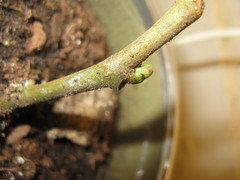
cutting in cup to right.
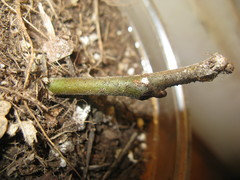
Steventobybul2 - Zone 6 SW MI
9 years agoLooks good. Similar to mine although I resorted to just plain moist sphagnum moss for the "soil" medium. I have quite a few that are being rooted from various sources. I am in the 4th week now and I am just seeing the good cuttings leaf out. No roots yet. In my case, I am finding that the quality of the cutting matters with whether they will leaf out or not. There are some that are molding and I think these are old cuttings that were most likely "dead" upon arrival. You could tell because they were dry. I have asked the sources to resend me fresh cuttings.
I am wondering if the people who sell them full time in eBay have a few stored and assume that their cuttings are ok.
tobybul2 - Zone 6 SW MI
9 years agoSorry, Here are 2 pics. One with mold on cutting. The other not so great. It leafed out nicely at first but because of too much moisture in cup cover the tips of the leaves started "rotting". So I opened the caps of the water bottle covers to air them.
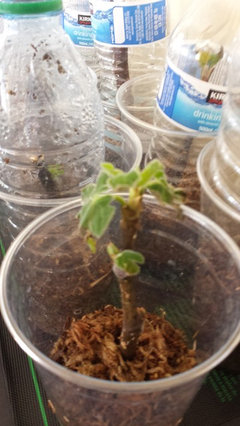
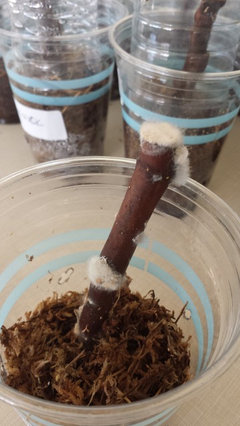
tobybul2 - Zone 6 SW MI
9 years agoOk Folks. I learned about hydroponic bubbler rooting today from a local store. Turns out theres a lot of info online also. This seems to be the way to go.
tapla (mid-Michigan, USDA z5b-6a)
9 years agoWhen rooting in water, the roots often transplant to soil very poorly. Learning to root in a solid, well-aerated medium is best.
Alponcirusguy6b452xx
9 years agoHere is my hardy chicago cuttings update
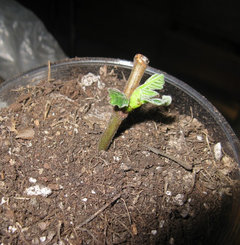
This is the same one above to the left on the heating duct. The other on died
tobybul2 - Zone 6 SW MI
9 years agoI have some cuttings in a hydroponic set up so so we'll see how it goes.




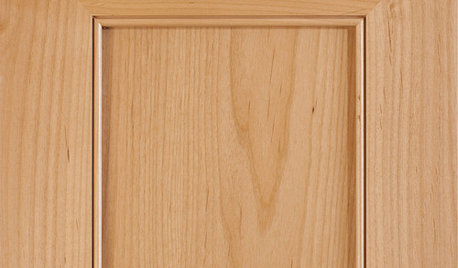











danab_z9_la